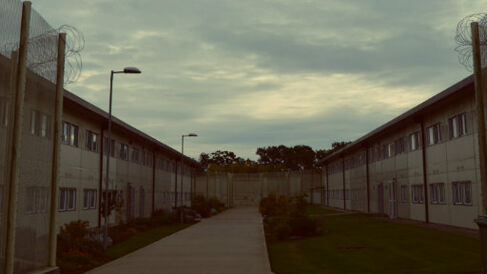Negotiation of geographies of power

Inventive techniques in the negotiation of geographies of power by Anna Schliehe
Dr Anna Schliehe is a Research Associate in the COMPEN team, Institute of Criminology, University of Cambridge.
Spending time in a medium-security prison holding mostly long-term prisoners convicted of sex offences recently, I heard many stories of the complicated nature of staff-prisoner relationships and the strategies employed by prisoners to negotiate every-day mobilities within the prison.
One story stuck with me in particular: in an interview we explored the question of how restrictive the prison environment feels and Ian[1] described how, when prisoners are off the wing and want to get back on it, they have to wait at a locked gate. Staff holding the keys are usually located in their office and have sight of that gate. Prisoners are required to wait and try and make eye contact or shout to get the staff’s attention. More often than not, staff are aware of prisoners waiting at the gate but take a long time to appear. Rumour has it that each wing used to have bells to get staff attention but that they were disabled on purpose because staff did not want to be in a position to have to get up and answer to prisoners – attend to them at the sound of a bell. Many prisoners rattle the gate and shout which is said to increase the time waiting outside. Ian, on the other hand, told me about how he developed a particular strategy to respond: when he approaches the gate, he makes eye contact so that they know he is there and then he lies down on the grass adjacent to the gate. Ever since adopting this course of action, he said, staff appear immediately – not just from his own wing but also from neighbouring wings. They complain that, according to the prison rules, he is not allowed to lie on the grass but he disagrees and asks to be shown the rule that says prisoners are not allowed to wait ‘horizontally’ or access the grass next to the wing. It turns out there is no such rule but ever since then staff have reacted immediately whenever he has waited at the gate.
The playing out of power in this scenario changed the staff-prisoner relationship and gave Ian a certain sense of achievement, though Ian said that this was not equivalent to power or control. He made clear that he had no control over his life in this environment, and was completely dependent on staff. In some respects, this form of agency had the desired effect, achieved through a form of well-thought-through utilisation of space and knowledge of the flows of power. However, at the same time, this small act of subversion also led to Ian being perceived by staff as manipulative and troublesome. Actions like this might therefore have an immediate positive effect but a more detrimental impact in the long-term. Imaginative ways of using the available space to ‘protest’ in peaceful and ultimately harmless ways shows how the geographies of power are deeply situated in the actual space of the prison. The assessment by members of staff shows how quickly this small form of protest or subversion can lead to a change in the perception of individual ‘risk’. Power is, amongst other ways, relayed through positioning the body, through politics of ‘looking and be seen’ (see also: Sibley and van Hoven 2009, van Hoven and Sibley 2008), measured by how fast or slow bodies move and challenged by breaking expected patterns of behaviour. The mobilities of the prison environment work in manifold ways (Peters and Turner 2017) and this example shows how slight detractions from the norm affect change.
Thinking through these examples of how power is negotiated and flows through prison spaces helps us to make sense of our own ethnographic observations and further develop how we ‘think through’ prisoners experience. This example shows how the weight of imprisonment might be shifted – even if only temporarily; and how invention and imagination change prisoners’ sense of agency.
Sources:
Peters, K.; Turner, J. (2017) Carceral Mobilities: a manifesto for mobilities, an agenda for carceral studies. In: Turner, J.; Peters, K. (eds) Carceral mobilities: Interrogating movement in incarceration. Routledge, London. Pp.1-15.
Sibley, D.; van Hoven, B. (2009) The Contamination of Personal Space: Boundary Construction in a Prison Environment. In: Area 41(2): 198-206.
Van Hoven, B.; Sibley, D. (2008) ‘Just duck’: The Role of Vision in the Production of Prison Space. In: Environment and Planning D: Society and Space 26: 1001-1017.
